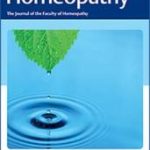Hemant P. Jadhav, Ghanshyam G. Chaudhari, Dipak D. Patil, Ramchandra B. Jadhav, Navya M. Reddy, Atul A. Shirkhedkar, Sameer N. Goyal, Chandragouda R. Patil
Standardization of homeopathic mother tincture of Toxicodendron pubescens and correlation of its flavonoid markers with the biological activity
Homeopathy, 2016, 105 (1), 48-54

Background – Standardization and quality control of homeopathic drugs is very challenging. As mother tinctures are derived from complex natural resources, there is a need of systematic evaluation of chemical markers which correlate with the proposed biological activities of mother tinctures.
Methods – In present study, High-Performance Thin-Layer Chromatography (HPTLC) standardization method of homeopathic mother tinctures of Toxicodendron pubescens using quercitrin and rutin as chemical markers is validated and correlations of content of these markers with its anti-inflammatory effects are established. For HPTLC analysis, precoated silica gel plates were used as stationary phase. Two flavonoids, namely quercitrin and rutin were used as markers. Separation was achieved using methylene chloride:methanol:water:glacial acetic acid (15:1.5:1:8 v/v/v) as mobile phase. The developed plates were scanned at 365 nm.
Results – It was observed that quercitrin (Rf value 0.63) and Rutin (Rf value 0.41) are well resolved. The minimum detectable concentrations for quercitrin and rutin were 5 ng/spot. The linearity range was between 100 and 2000 ng/spot for both the markers. Subsequently, anti-inflammatory activity of these formulations was determined against carrageenan-induced paw edema in rats, pain threshold determined by electronic Von-Frey apparatus and paw withdrawal latency (PWL) on hot-plate. All the tested formulations of Rhus Tox showed anti-inflammatory and analgesic activity against carrageenan induced paw edema in rats. Quantitative correlation between the content of markers and anti-inflammatory activity of mother tinctures was established. Results: Anti-inflammatory effect as well as effect on paw withdrawal and pain threshold, at third hour after carrageenan injection, correlated with quercitrin and rutin content in the respective formulations.
Conclusions – his study validates a quantitative HPTLC method for standardization of homeopathic mother tincture of Rhus Tox and establishes quercitrin and rutin as markers corresponding its biological activity. Contents of quercitrin and rutin in T. pubescens mother tincture correlates with its anti-inflammatory and analgesic actions and the validated HPTLC method can be used in standardization of homeopathic mother tincture of T. pubescens.





